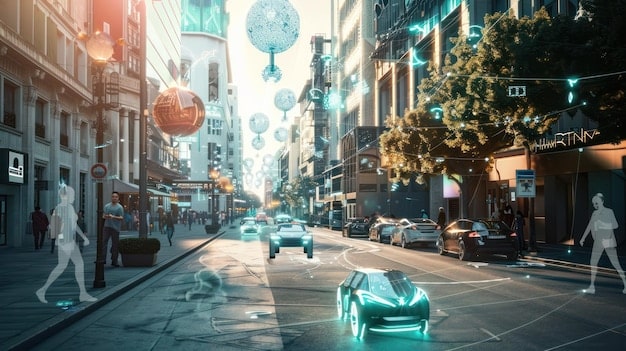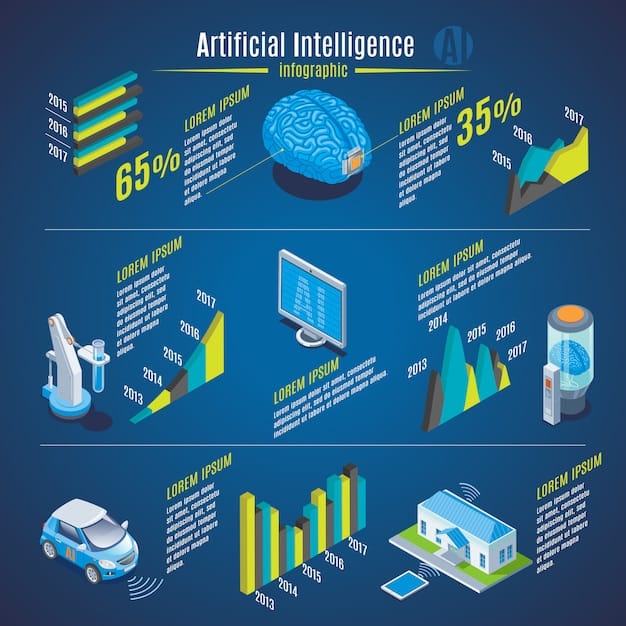AI & Autonomous Vehicles: Ethical and Legal Challenges in the US

AI and autonomous vehicles in the US present complex ethical dilemmas and liability considerations, demanding careful navigation of safety, privacy, and legal frameworks.
The rise of AI and autonomous vehicles: Ethical dilemmas and liability considerations in the US, presents a complex web of challenges for policymakers, manufacturers, and the public. As these technologies become increasingly integrated into our daily lives, it’s crucial to examine the ethical implications and address the legal uncertainties surrounding their deployment.
Understanding the Landscape of AI and Autonomous Vehicles
Autonomous vehicles (AVs) are rapidly evolving, powered by artificial intelligence (AI) to perceive their surroundings and make driving decisions. This technology holds the promise of increased safety, reduced traffic congestion, and improved accessibility for individuals with mobility limitations. However, the widespread adoption of AVs presents significant ethical and legal hurdles that must be carefully addressed.
The Evolution of Autonomous Driving
Autonomous vehicles are classified into different levels of automation, ranging from Level 0 (no automation) to Level 5 (full automation). As vehicles progress towards higher levels of autonomy, the role of AI becomes increasingly critical. AI algorithms are responsible for tasks such as sensor data fusion, object recognition, path planning, and decision-making.
Key Components of AI in Autonomous Vehicles
- Machine Learning: Enabling vehicles to learn from data and improve their performance over time.
- Computer Vision: Allowing vehicles to “see” and interpret their environment through cameras and sensors.
- Natural Language Processing: Facilitating communication between vehicles and passengers, as well as understanding voice commands.
The complexity of these AI systems raises concerns about their reliability, safety, and potential for unintended consequences. Understanding these challenges is essential for developing effective regulatory frameworks and promoting responsible innovation in the autonomous vehicle industry.
In this section, we have introduced the fundamental aspects of AI in autonomous vehicles, setting the stage for a deeper exploration of the ethical and liability considerations in the subsequent sections.

Ethical Dilemmas in Autonomous Vehicle Programming
One of the most pressing ethical concerns surrounding autonomous vehicles is the question of how they should be programmed to handle unavoidable accident scenarios. These “trolley problems” force programmers to make difficult choices about which lives to prioritize in the event of a collision.
The Trolley Problem and Autonomous Vehicles
The trolley problem is a classic thought experiment in ethics that presents a scenario where a decision-maker must choose between sacrificing one life to save a larger group. In the context of autonomous vehicles, this could involve choosing whether to swerve to avoid hitting pedestrians, potentially endangering the vehicle’s occupants.
Algorithmic Bias and Fairness
AI algorithms used in autonomous vehicles can be susceptible to bias, leading to unfair or discriminatory outcomes. For example, if a vehicle’s object recognition system is trained primarily on data from one demographic group, it may be less accurate in identifying individuals from other groups, potentially increasing the risk of accidents.
- Data Bias: Ensuring that training data is representative of the diverse populations and environments in which the vehicles will operate.
- Algorithmic Transparency: Promoting transparency in the design and development of AI algorithms to identify and mitigate potential biases.
- Ethical Frameworks: Developing ethical guidelines and standards for AI development that prioritize fairness, accountability, and transparency.
By addressing these ethical dilemmas proactively, we can ensure that autonomous vehicles are developed and deployed in a manner that benefits all members of society.
This section explored the complex ethical considerations that arise in the programming of autonomous vehicles, emphasizing the need for careful thought and proactive measures to address potential biases and ensure fairness.
Liability Considerations in Autonomous Vehicle Accidents
Determining liability in the event of an accident involving an autonomous vehicle is a complex legal challenge. Unlike traditional car accidents, where human error is often a primary factor, AV accidents may involve a combination of factors, including software glitches, sensor malfunctions, and unforeseen environmental conditions.
Current Legal Frameworks and Challenges
Existing legal frameworks are often ill-equipped to handle the unique challenges posed by autonomous vehicle accidents. Traditional negligence laws may not be applicable when there is no human driver to blame. This raises questions about who should be held liable in such cases.
Potential Liable Parties
- The Vehicle Manufacturer: If the accident was caused by a defect in the vehicle’s design or manufacturing.
- The Software Developer: If the accident was caused by a flaw in the AI algorithms or software powering the vehicle.
- The Vehicle Owner: If the owner failed to properly maintain the vehicle or misused its autonomous capabilities.
The Role of Regulation
Clear and comprehensive regulations are needed to address the liability complexities of autonomous vehicles. These regulations should establish standards for vehicle safety, data collection, and accident reporting. They should also provide guidance on how to allocate liability in the event of an accident.
Addressing the legal complexities surrounding AV accidents is crucial for fostering public trust and ensuring that victims of accidents are fairly compensated.
This section delved into the complex liability considerations that arise in autonomous vehicle accidents, highlighting the challenges posed by current legal frameworks and emphasizing the need for clear and comprehensive regulations.
Data Privacy and Security Concerns
Autonomous vehicles generate vast amounts of data about their surroundings, including location data, driving patterns, and even images and videos of pedestrians and other vehicles. This data raises significant privacy and security concerns that must be addressed to protect individuals’ rights and prevent misuse.
The Scope of Data Collection
AVs are equipped with a variety of sensors, including cameras, radar, and lidar, that collect data about the vehicle’s environment. This data is used to enable the vehicle to navigate safely and make driving decisions. However, it can also be used for other purposes, such as tracking individuals’ movements and profiling their behavior.
Data Security Risks
The data collected by AVs is vulnerable to hacking and other security breaches. If this data falls into the wrong hands, it could be used for malicious purposes, such as identity theft, stalking, or even sabotage of the vehicle’s systems. Protecting this data requires robust security measures and constant vigilance.

Strategies for Protecting Data Privacy
Several strategies can be employed to protect data privacy in the context of autonomous vehicles:
- Data Minimization: Collecting only the data that is necessary for the vehicle to function safely and efficiently.
- Data Anonymization: Removing personally identifiable information from the data before it is stored or shared.
- Data Encryption: Protecting data with encryption algorithms to prevent unauthorized access.
Protecting data privacy and security is essential for building public trust in autonomous vehicles and ensuring that these technologies are used responsibly.
This section highlighted the significant data privacy and security concerns associated with autonomous vehicles, emphasizing the need for robust security measures and ethical data handling practices.
The Impact on Employment and the Workforce
The widespread adoption of autonomous vehicles is likely to have a significant impact on employment, particularly in industries such as transportation and logistics. While AVs may create new job opportunities in areas such as AI development and vehicle maintenance, they are also likely to displace workers in traditional driving roles.
Potential Job Losses
Truck drivers, taxi drivers, and delivery drivers are among the workers who could be most affected by the deployment of autonomous vehicles. As AVs become more capable and reliable, companies may choose to replace human drivers with automated systems, leading to job losses and economic disruption.
Opportunities for Job Creation
The rise of autonomous vehicles is also likely to create new job opportunities in areas such as AI development, vehicle maintenance, and data analysis. These jobs may require different skills and training than traditional driving roles, highlighting the need for workforce development programs to help workers transition to new careers.
Mitigating the Negative Impacts
Policymakers and industry leaders can take steps to mitigate the negative impacts of AVs on employment:
- Investing in Workforce Development: Providing training and education programs to help workers acquire the skills needed for new jobs in the AV industry.
- Creating Safety Nets: Establishing social safety nets to support workers who lose their jobs due to automation.
- Promoting Ethical Innovation: Encouraging the development of AV technologies that prioritize job creation and worker well-being.
By addressing the potential impact on employment proactively, we can ensure that the benefits of autonomous vehicles are shared more widely and that workers are not left behind.
This section explored the potential impact of autonomous vehicles on employment and the workforce, highlighting the need for proactive measures to mitigate job losses and support workers in transitioning to new careers.
The Future of AI and Autonomous Vehicles in the US
The future of AI and autonomous vehicles in the US is likely to be shaped by a combination of technological advancements, regulatory developments, and societal acceptance. As these technologies continue to evolve, it is crucial to address the ethical dilemmas and liability considerations that arise to ensure that they are deployed in a safe, responsible, and equitable manner.
Technological Advancements
AI algorithms are becoming more sophisticated, sensors are becoming more accurate, and computing power is increasing exponentially. These advancements are driving the development of more capable and reliable autonomous vehicles, paving the way for their widespread adoption.
Regulatory Developments
Federal and state regulators are working to develop comprehensive frameworks for governing the deployment of autonomous vehicles. These frameworks will address issues such as vehicle safety standards, data privacy, and liability in the event of accidents. The goal is to create a regulatory environment that fosters innovation while protecting public safety and individual rights.
Societal Acceptance
Public acceptance of autonomous vehicles is crucial for their successful integration into society. Building trust in these technologies requires transparency, education, and open dialogue about the risks and benefits. As people become more familiar with AVs and see their potential to improve safety and convenience, acceptance is likely to grow.
By working together to address the ethical dilemmas and liability considerations surrounding AI and autonomous vehicles, we can create a future where these technologies benefit all members of society.
This section looked ahead to the future of AI and autonomous vehicles in the US, emphasizing the importance of technological advancements, regulatory developments, and societal acceptance in shaping their trajectory.
| Key Point | Brief Description |
|---|---|
| 🤔 Ethical Dilemmas | AVs face “trolley problems,” requiring choices on prioritizing lives in accidents. |
| ⚖️ Liability Issues | Determining fault in AV accidents is complex due to AI and software factors. |
| 🔒 Data Privacy | AVs collect vast data, demanding strong privacy and security measures. |
| 💼 Job Impact | AVs may displace drivers but create new tech and maintenance jobs. |
FAQ
▼
Programming for unavoidable accidents and algorithmic bias are key concerns. AVs must make choices about prioritizing lives in collision scenarios, raising ethical dilemmas about whose safety comes first.
▼
Liability can fall on the vehicle manufacturer, software developer, or owner, depending on the cause. Determining the responsible party is complex due to the AI and software involved in AV operation.
▼
Data minimization, anonymization, and encryption are used. Only necessary data is collected, personal information is removed, and encryption safeguards data from unauthorized access, protecting user privacy.
▼
AVs may displace drivers but create jobs in AI and maintenance. Truck, taxi, and delivery drivers face potential job losses, while new opportunities arise in technology and vehicle servicing sectors.
▼
Clear standards for safety, data collection, and accident reporting are required. Regulations must promote innovation while ensuring public safety and protecting individual rights, balancing progress with responsibility.
Conclusion
Addressing the ethical and legal challenges surrounding AI and autonomous vehicles is paramount. As these technologies advance, creating comprehensive regulations, fostering transparency, and prioritizing data privacy are crucial for ensuring a safe, equitable, and beneficial future for all.





